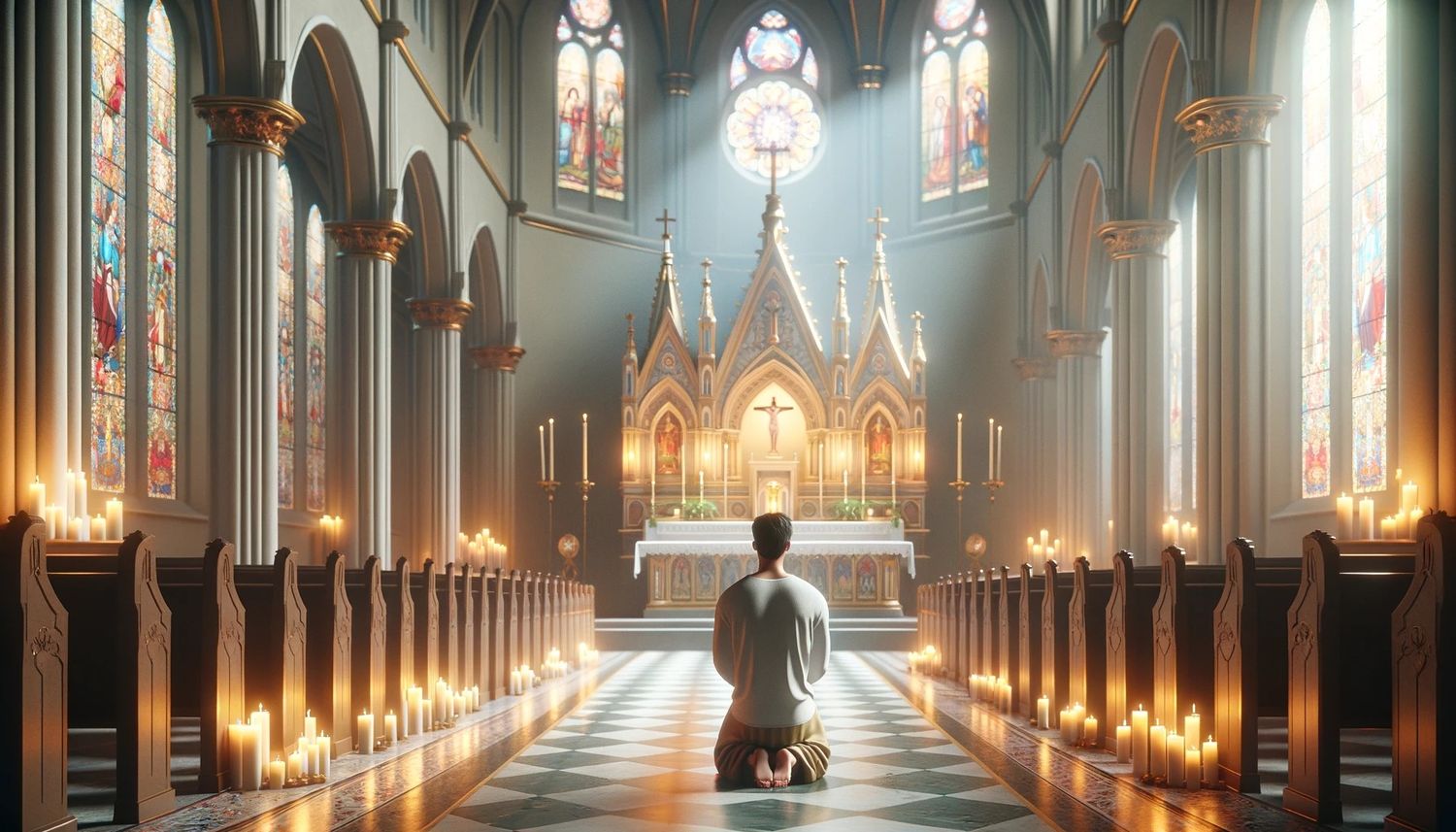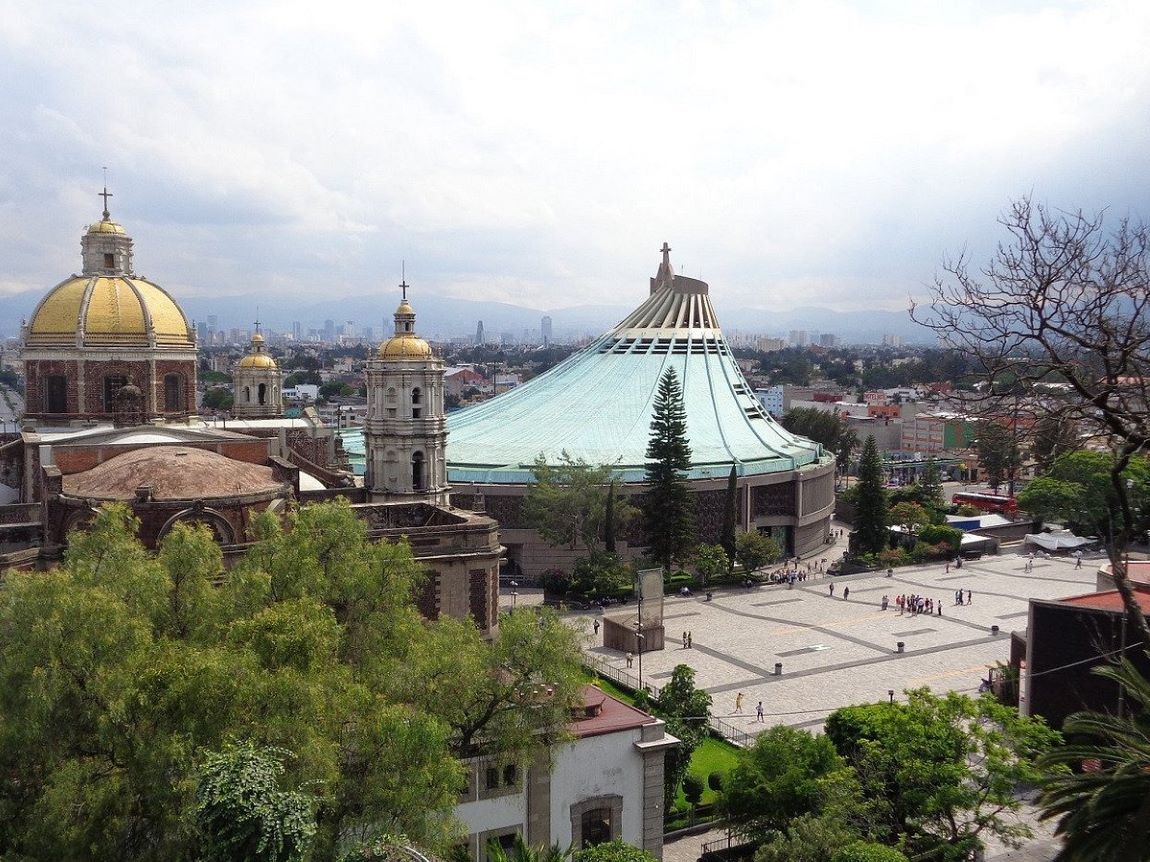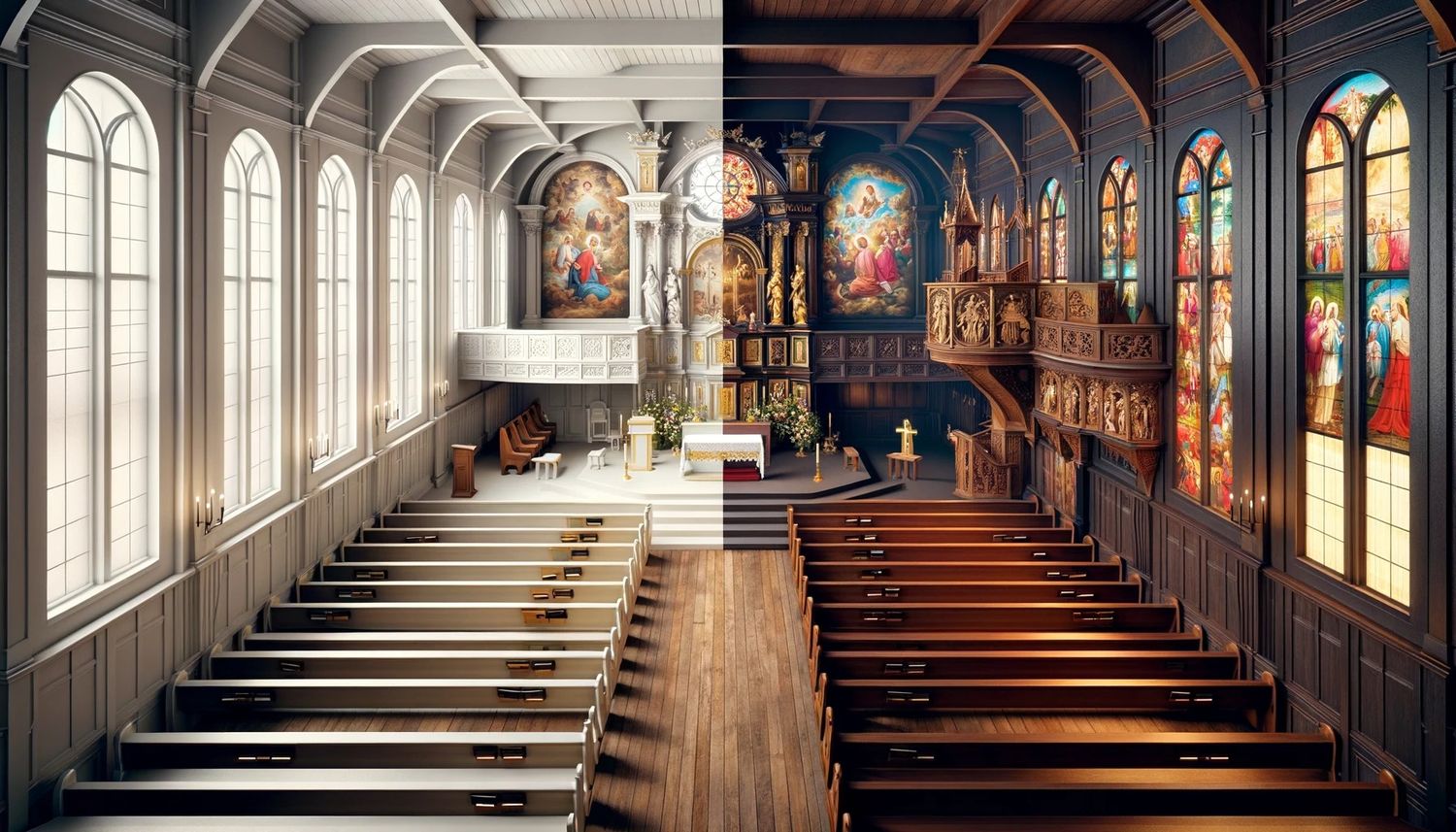Home>Theology and Spirituality>How Was Catholicism Brought To Mexico


Theology and Spirituality
How Was Catholicism Brought To Mexico
Published: February 17, 2024
Jason DeRose, Managing Editor at Christian.net, uses his expertise in religion and journalism to deepen understanding of faith's societal impacts. His editorial leadership, coupled with a strong academic background, enriches the platform’s diverse content, earning him recognition in both journalism and religious circles.
Discover the history of Catholicism in Mexico and how it was introduced, shaping the country's theology and spirituality. Explore the impact of this religious influence on Mexican culture and society.
(Many of the links in this article redirect to a specific reviewed product. Your purchase of these products through affiliate links helps to generate commission for Christian.net, at no extra cost. Learn more)
Table of Contents
Introduction
The introduction of Catholicism to Mexico is a fascinating and complex historical journey that intertwines religion, culture, and conquest. It is a story that spans centuries and encompasses the collision of two vastly different worlds. The arrival of Catholicism in Mexico not only transformed the spiritual landscape of the region but also left an indelible mark on its cultural identity.
The narrative of Catholicism in Mexico begins with the early Spanish conquest of the Aztec Empire in the 16th century. This pivotal moment in history marked the collision of two distinct civilizations, each with its own set of beliefs, traditions, and worldviews. The encounter between the Spanish conquistadors and the indigenous peoples of Mexico set the stage for the introduction of Catholicism to the New World.
As we delve into the historical tapestry of Catholicism in Mexico, we will uncover the profound impact of this religious tradition on the indigenous cultures of the region. The arrival of Catholic missionaries, the conversion of indigenous peoples, and the establishment of the Catholic Church in Mexico all played pivotal roles in shaping the spiritual and cultural landscape of the country.
Furthermore, the enduring influence of Catholicism on Mexican culture cannot be overstated. From religious practices and rituals to art, architecture, and societal norms, the imprint of Catholicism is deeply woven into the fabric of Mexican identity. Exploring the multifaceted ways in which Catholicism has permeated Mexican society offers a rich tapestry of historical, spiritual, and cultural significance.
As we embark on this exploration of how Catholicism was brought to Mexico, we will unravel the intricate threads of history, spirituality, and cultural exchange that have shaped the religious landscape of this vibrant and diverse nation. Through this journey, we will gain a deeper understanding of the enduring legacy of Catholicism in Mexico and its profound impact on the country's cultural heritage.
Read more: When Was Catholicism Brought Into Peru
Early Spanish Conquest of Mexico
The early Spanish conquest of Mexico stands as a pivotal chapter in the annals of history, marking the collision of two vastly different worlds and the dawn of a new era. In the early 16th century, Spanish conquistadors, led by Hernán Cortés, set sail for the New World in search of wealth, glory, and the expansion of the Spanish Empire. Their arrival on the shores of Mexico in 1519 would forever alter the course of history and profoundly impact the spiritual and cultural landscape of the region.
The Spanish conquest of Mexico was characterized by a complex interplay of military conquest, political maneuvering, and cultural exchange. Hernán Cortés and his expedition encountered the mighty Aztec Empire, ruled by the renowned emperor Moctezuma II. Despite being vastly outnumbered, the Spanish conquistadors, equipped with advanced weaponry and aided by indigenous allies who resented Aztec rule, managed to topple the formidable empire.
The fall of the Aztec Empire in 1521 marked the culmination of the Spanish conquest of Mexico. The conquest was not merely a military triumph; it also served as a catalyst for the introduction of Spanish culture, language, and, significantly, Catholicism to the indigenous peoples of Mexico. The conquest paved the way for the dissemination of Catholicism as a cornerstone of Spanish colonial rule and evangelization efforts in the New World.
The encounter between the Spanish conquistadors and the indigenous peoples of Mexico was a clash of civilizations, each with its own set of beliefs, traditions, and worldviews. The imposition of Catholicism by the Spanish crown as the official religion of the newly conquered territories laid the groundwork for the profound transformation of the spiritual landscape of Mexico. The early Spanish conquest of Mexico thus set in motion a series of events that would forever intertwine the destinies of Catholicism and the indigenous cultures of the region.
The legacy of the early Spanish conquest of Mexico reverberates through the annals of history, leaving an indelible mark on the religious, cultural, and societal fabric of the country. The collision of Spanish and indigenous cultures during this tumultuous period laid the foundation for the enduring influence of Catholicism on the spiritual and cultural identity of Mexico.
The early Spanish conquest of Mexico, with its complex tapestry of conquest, cultural exchange, and religious transformation, serves as a pivotal juncture in the narrative of Catholicism's introduction to the New World. This historical chapter set the stage for the arrival of Catholic missionaries and the subsequent conversion of indigenous peoples, shaping the course of Mexican history and spirituality for centuries to come.
Arrival of Catholic Missionaries
Following the Spanish conquest of Mexico, the arrival of Catholic missionaries heralded a new chapter in the history of the region. These devoted emissaries of the Catholic Church embarked on a mission to evangelize the indigenous peoples of Mexico, spreading the teachings of Christianity and establishing a religious foothold in the newly conquered territories.
The arrival of Catholic missionaries in Mexico was a pivotal moment that marked the formal introduction of Christianity to the indigenous populations. These missionaries, driven by fervent religious zeal and a sense of divine calling, ventured into the heart of the New World, braving untold hardships and challenges to fulfill their sacred mandate.
Led by prominent figures such as Friar Pedro de Gante and Friar Bernardino de Sahagún, the Catholic missionaries undertook the arduous task of imparting the tenets of the Christian faith to the indigenous peoples of Mexico. Their efforts were characterized by a deep commitment to religious outreach, cultural understanding, and the establishment of Christian communities in the midst of unfamiliar and often hostile environments.
The arrival of Catholic missionaries in Mexico also brought with it the dissemination of religious texts, the construction of churches and monasteries, and the incorporation of Christian rituals and practices into the fabric of indigenous societies. The missionaries sought to supplant traditional indigenous beliefs and practices with the doctrines of Catholicism, viewing their mission as a divine imperative to save the souls of the indigenous peoples from perceived spiritual darkness.
The presence of Catholic missionaries in Mexico engendered a profound and enduring legacy, shaping the religious, cultural, and societal landscape of the region. Their unwavering dedication to the propagation of the Christian faith left an indelible mark on the spiritual identity of Mexico, laying the groundwork for the establishment of the Catholic Church as a dominant force in the lives of the indigenous populations.
The arrival of Catholic missionaries in Mexico thus stands as a testament to the enduring impact of religious fervor and missionary zeal in the annals of history. Their endeavors paved the way for the conversion of indigenous peoples, the establishment of Christian communities, and the enduring influence of Catholicism on the cultural heritage of Mexico.
The arrival of Catholic missionaries in Mexico marked a transformative juncture in the history of the region, heralding the dawn of a new era characterized by the fusion of Spanish and indigenous cultures and the enduring legacy of Catholicism in the spiritual and cultural tapestry of Mexico.
Conversion of Indigenous Peoples
The conversion of indigenous peoples to Catholicism in Mexico represents a profound and multifaceted historical process that unfolded in the wake of the Spanish conquest. The arrival of Catholic missionaries and the subsequent evangelization efforts aimed to supplant traditional indigenous beliefs and practices with the tenets of Christianity, marking a pivotal juncture in the spiritual and cultural transformation of the region.
The conversion of indigenous peoples to Catholicism was a complex and often contentious endeavor, characterized by a convergence of religious, cultural, and socio-political dynamics. The Catholic missionaries, driven by a fervent zeal to spread the Christian faith, sought to impart the doctrines of Catholicism to the indigenous populations, viewing their mission as a divine imperative to save souls and eradicate perceived spiritual "paganism."
The process of conversion unfolded through a variety of means, including the dissemination of Christian teachings, the construction of churches and religious institutions, and the incorporation of Christian rituals and practices into the fabric of indigenous societies. The missionaries endeavored to instill a sense of religious devotion and allegiance to the Catholic Church, often employing persuasive tactics and adapting their approach to resonate with the cultural sensibilities of the indigenous peoples.
The conversion of indigenous peoples to Catholicism also engendered a profound reconfiguration of spiritual and cultural identities. Traditional indigenous belief systems, cosmologies, and rituals were gradually supplanted by the doctrines and practices of Catholicism, leading to a profound transformation of the indigenous worldview and religious landscape. The syncretic fusion of indigenous and Christian elements gave rise to unique religious expressions and cultural traditions that continue to permeate the fabric of Mexican society.
The impact of the conversion process reverberated across generations, shaping the spiritual, social, and cultural dynamics of indigenous communities. The enduring legacy of Catholicism in Mexico is intricately intertwined with the complex legacy of indigenous resilience, adaptation, and cultural hybridity, reflecting a rich tapestry of spiritual and cultural syncretism that continues to define the cultural heritage of the region.
The conversion of indigenous peoples to Catholicism thus stands as a testament to the enduring legacy of religious and cultural exchange, underscoring the profound impact of Catholicism on the spiritual and cultural identity of Mexico. This transformative process serves as a poignant reminder of the intricate interplay between faith, tradition, and cultural adaptation in the historical narrative of the region.
Establishment of Catholic Church in Mexico
The establishment of the Catholic Church in Mexico represents a pivotal chapter in the historical narrative of the region, marking the institutionalization of Catholicism as a dominant religious and cultural force. Following the arrival of Spanish conquistadors and Catholic missionaries, the Catholic Church emerged as a central institution that wielded significant influence over the spiritual, social, and political dynamics of Mexico.
The Spanish conquest of Mexico laid the groundwork for the formal establishment of the Catholic Church in the newly conquered territories. Under the auspices of the Spanish crown, the Catholic Church played a central role in the process of colonization and evangelization, serving as a cornerstone of Spanish colonial rule and religious hegemony. The construction of churches, monasteries, and religious institutions became emblematic of the Church's enduring presence in the fabric of Mexican society, solidifying its status as a pervasive and enduring institution.
The establishment of the Catholic Church in Mexico also entailed the appointment of bishops, clergy, and religious orders to oversee the spiritual affairs of the burgeoning Christian communities. These ecclesiastical authorities assumed pivotal roles in shaping the religious and cultural landscape of Mexico, exerting influence over matters of faith, morality, and social organization. The Church's hierarchical structure and doctrinal authority permeated the lives of the indigenous populations, shaping their religious practices, worldviews, and societal norms.
Furthermore, the Catholic Church played a central role in the assimilation and acculturation of indigenous peoples into the fold of Christianity. The Church's evangelization efforts sought to instill a sense of religious devotion and allegiance to Catholic doctrine, often intertwining indigenous cultural elements with Christian rituals and practices. This syncretic fusion gave rise to unique religious expressions and cultural traditions that reflected the complex interplay between Spanish and indigenous influences.
The enduring legacy of the Catholic Church in Mexico is indelibly woven into the spiritual, cultural, and societal fabric of the country. Its establishment not only shaped the religious identity of Mexico but also left an indelible mark on its artistic, architectural, and intellectual heritage. The fusion of Spanish Catholicism and indigenous cultural elements engendered a rich tapestry of religious syncretism that continues to define the cultural landscape of Mexico.
The establishment of the Catholic Church in Mexico thus stands as a testament to the enduring legacy of religious and cultural exchange, underscoring the profound impact of Catholicism on the spiritual and cultural identity of the region. This transformative process serves as a poignant reminder of the intricate interplay between faith, tradition, and cultural adaptation in the historical narrative of Mexico.
Read more: Who Brought Catholicism To Japan
Impact of Catholicism on Mexican Culture
The impact of Catholicism on Mexican culture is profound and multifaceted, permeating every aspect of the country's artistic, architectural, social, and spiritual heritage. From religious practices and rituals to art, music, and societal norms, the imprint of Catholicism is deeply interwoven into the fabric of Mexican identity.
One of the most visible manifestations of Catholicism's influence on Mexican culture is evident in the realm of art and architecture. The construction of ornate cathedrals, churches, and religious monuments stands as a testament to the fusion of Spanish Baroque aesthetics and indigenous artistic traditions. The intricate blend of European and indigenous motifs, symbols, and iconography reflects the syncretic nature of Mexican religious art, encapsulating the convergence of diverse cultural influences.
Furthermore, Catholicism has profoundly shaped the religious landscape of Mexico, giving rise to a rich tapestry of religious festivals, processions, and devotional practices. The celebration of religious holidays, such as Semana Santa (Holy Week) and the Feast of Our Lady of Guadalupe, serves as a vibrant expression of Mexican Catholicism, blending solemn religious observances with colorful pageantry and cultural traditions.
The impact of Catholicism on Mexican culture also extends to the realm of societal norms and values. The influence of Catholic moral teachings and ethical principles has left an indelible mark on the social fabric of Mexico, shaping attitudes towards family, community, and the sanctity of life. The concept of "familismo," emphasizing the central role of the family unit, is deeply rooted in Catholic values and has become a cornerstone of Mexican social identity.
Moreover, the enduring legacy of Catholicism in Mexico is reflected in the realm of music, literature, and popular culture. Religious hymns, devotional songs, and traditional folk music often bear the indelible imprint of Catholic themes and imagery, serving as a poignant reflection of the spiritual and cultural resonance of Mexican Catholicism.
In essence, the impact of Catholicism on Mexican culture is a testament to the enduring legacy of religious syncretism and cultural exchange. The fusion of Spanish Catholicism and indigenous traditions has given rise to a vibrant and multifaceted cultural tapestry that continues to define the rich and diverse heritage of Mexico.
Conclusion
In conclusion, the introduction of Catholicism to Mexico represents a pivotal chapter in the historical narrative of the region, marking the convergence of Spanish and indigenous cultures and the enduring legacy of religious and cultural exchange. The early Spanish conquest of Mexico, characterized by the collision of two distinct civilizations, set the stage for the arrival of Catholic missionaries and the subsequent conversion of indigenous peoples to the Christian faith. The establishment of the Catholic Church in Mexico solidified the institutional presence of Catholicism as a dominant force in the spiritual, cultural, and societal dynamics of the country.
The impact of Catholicism on Mexican culture is profound and far-reaching, permeating every facet of the country's artistic, architectural, social, and spiritual heritage. From religious practices and rituals to art, music, and societal norms, the imprint of Catholicism is deeply interwoven into the fabric of Mexican identity. The fusion of Spanish Catholicism and indigenous cultural elements has given rise to a rich tapestry of religious syncretism that continues to define the cultural landscape of Mexico.
The enduring legacy of Catholicism in Mexico serves as a poignant reminder of the intricate interplay between faith, tradition, and cultural adaptation in the historical narrative of the region. The syncretic fusion of Spanish and indigenous influences has engendered a unique and vibrant cultural heritage that reflects the complex and multifaceted nature of Mexican identity.
As we reflect on the historical journey of how Catholicism was brought to Mexico, we gain a deeper understanding of the profound and enduring impact of religious and cultural exchange. The convergence of Spanish and indigenous cultures, the conversion of indigenous peoples, and the establishment of the Catholic Church have collectively shaped the spiritual and cultural landscape of Mexico, leaving an indelible mark on its identity.
In essence, the introduction of Catholicism to Mexico stands as a testament to the enduring legacy of religious syncretism, cultural resilience, and the rich tapestry of historical, spiritual, and cultural significance that continues to define the vibrant and diverse heritage of the country.














